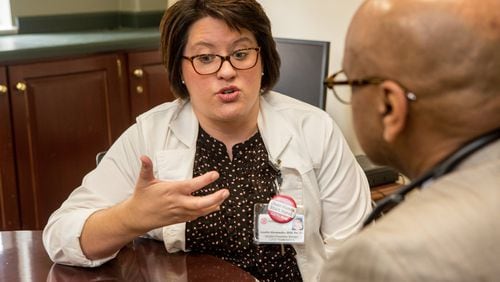Doctors and administrators at DeKalb Medical Center are leading their hospitals’ campaign against one of medicine’s most pressing and preventable problems – healthcare-associated infections (HAIs).
For the past year, they’ve been wearing hard-to-miss buttons on their lab coats that promote hand hygiene, considered the first and best defense against urinary tract infections and other HAIs.
The buttons are designed to encourage patients and staff to ask about a caregiver’s hand hygiene and to open a dialogue about its importance for good health.
“The CDC states that the No. 1 way to prevent HAIs is through hand hygiene, and that’s why we’ve made that our focus,” said Jennifer Shankweiler, DeKalb Medical Center’s infection prevention manager. “It’s the simplest thing that anybody and everybody can and should do to keep patients and themselves safe while they are here in the hospital.”
Catheter-related infections recently have fallen by 50 percent at DeKalb Medical at Hillandale in Lithonia and by 25 percent at DeKalb Medical Center North in Decatur, Shankweiler said.
“This is due to a combined strategy focusing on hand hygiene and implementation of best practices, she said.
On any given day, roughly one in 25 acute care hospital patients in the United States develop at least one HAI while being treated for another condition, according to the Centers for Disease Control and Prevention. About 75,000 of those patients die annually during hospitalization, the latest CDC figures show.
Nationally, as well as locally, progress is being made to reduce some HAIs. But from hospital boardrooms to Washington, there’s widespread acknowledgment that much more needs to be done.
HAIs, the CDC has identified, include:
• Central line-associated bloodstream infections (CLABSIs), which happen when a central line (a tube that a doctor usually places in a large vein of a patient’s neck or chest to give important medical treatment) is not put in correctly or not kept clean. This allows the central line to become a way for germs to enter the body and cause deadly infections in the blood.
• Catheter-associated urinary tract infections (CAUTIs), which involve any part of the urinary system, including urethra, bladder, and kidney. When a urinary catheter is not put in correctly, not kept clean, or left in a patient for too long, germs can travel through the catheter and infect the bladder and kidneys.
• Surgical site infections (SSIs) are infections, which occur after surgery on the part of the body where the surgery was performed. Sometimes, these infections involve only the skin. Other SSIs can involve tissues under the skin, organs, or implanted material.
• Hospital-onset Clostridium difficile (C. difficile) infections, which can cause life-threatening diarrhea. When a person takes antibiotics, good bacteria that protect against infection are destroyed for several months. During this time, patients can get sick from C. difficile.
• Hospital-onset methicillin-resistant Staphylococcus aureus (MRSA) bacteremia (bloodstream infections), which is caused by a type of staph bacteria that is resistant to many antibiotics.
The CDC regularly publishes an HAI Progress Report. The latest one, which came out in 2016 and relies on 2014 data, found that the nation’s acute care hospitals had:
• a 50-percent decrease in central line-associated bloodstream infections (CLABSI) between 2008 and 2014;
• no change in overall catheter-associated urinary tract infections (CAUTI) between 2009 and 2014
• a 17-percent decrease in surgical site infections (SSI) related to the 10 select procedures tracked in previous reports;
• a 17-percent decrease in abdominal hysterectomy SSI between 2008 and 2014;
The case in Georgia
The CDC’s 2016 report showed mixed results for Georgia’s hospitals. For instance, central-line associated bloodstream infections were 36 percent lower than the national baseline. But catheter-associated associated urinary tract infections were up 14 percent compared to the national baseline and bloodstream infections usually spread by contaminated hands were up 5 percent.
Jeanne Negley, the Georgia Department of Public Health’s health-care-associated infections surveillance director, said the state is monitoring HAIs through the National Healthcare Safety Network (NHSN).
The surveillance system, which was developed by the CDC, has shown decreases in the infection rates at Georgia hospitals, Negley said. For instance, a comparison of 2015 and 2016 NHSN data indicates Georgia hospitals have reduced Clostridium difficile infections, she said.
“We will continue to reduce these infections with our statewide antibiotic stewardship program,” Negley said.
The 2015-2016 data comparison also indicates that the state needs to improve central line-associated bloodstream infections (CLABSIs) in certain hospital units and catheter-associated urinary tract infections (CAUTIs) in long-term acute care hospitals, she said.
“Given that the Georgia Hospital Association (GHA) has experienced recent success in further reducing these infections, we will partner with GHA to work with additional hospitals to impact the overall state rate,” Negley said.
The prevention and reduction of healthcare-associated infections is a top priority of the U.S. Department of Health and Human Services (HHS). A primary focus has been antibiotic use, which the public health community has long recognized puts patients at risk for C. difficile infection.
At DeKalb Medical, the hand-hygiene buttons are one aspect of the HAI reduction strategy. The hand-hygiene campaign has been expanded with a video contest in which seven departments developed creative hand-cleaning promotional videos. The videos now appear on the hospitals’ closed-circuit televisions and Facebook page.
The medical center also has plans to include signage in patient rooms, encouraging patients and their families to ask nurses, doctors, and other staff if they’ve sanitized their hands, Shankweiler said.
“Additionally, the staff has been focusing efforts on proper utilization and removal of central lines and urinary catheters,” said Ellen Hargett, executive director of DeKalb’s Quality Institute.
“We’re really challenging care providers to always focus on what is the safest thing for our patients,” Hargett said. “We’ve asked our staff to prioritize doing the right thing, which means you always clean your hands entering and exiting a patient care room every time, as well as minimizing the use of invasive devices.”
The terminology
Hospital-acquired condition (HAC) is a term used by the Centers for Medicare & Medicaid Services (CMS) and all hospitals to describe an undesirable event that occurs while a patient is receiving treatment. These include, but are not limited to, falls with injury, pressure ulcers, and hospital-acquired infections.
Healthcare-associated infections (HAI) are a subset of HAC specific to infections that patients develop while receiving treatment for other conditions within a healthcare setting. The healthcare setting could be a hospital, nursing home, dialysis center or rehabilitation center. Common types of infections that patients acquire in the hospital are pneumonia and surgical site infections.
About the Author






